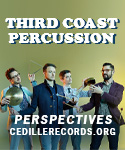Although billed as “early” chamber music, it’s worth noting that most of this music was written between Ralph Vaughan Williams’ mid-20s (1898) and mid-30s (1906), and although he disparaged and suppressed almost all of the music that he composed prior to his studies with Ravel, many aspects of his mature style are clearly in place, albeit in embryonic form. Of course, Vaughan Williams wrote comparatively little chamber music, but that makes these works all the more valuable not only as harbingers of things to come, but also as important contributions to his catalog in their own right. The fact that they contain reminiscences of Brahms and Dvorák and lack originality doesn’t necessarily mean that these pieces are bad or inferior.
Of the three large works–Piano Quintet in C minor, String Quartet in C minor, and Quintet in D minor for clarinet, horn, violin, cello, and piano–it’s the two quintets that make the best impression. The Piano Quintet (with double bass instead of second violin), comprised of three bold movements, takes full advantage of the textural possibilities of this particular combination and offers countless glimpses of an emerging personal style, including modal, folk-like themes, and a preference (evident in all of the works that employ it) for the dusky tone of the viola. The D minor Quintet also sounds a personal note, particularly in the first movement’s second subject and the finale, and the parts for the two wind instruments are very satisfyingly integrated into the overall texture (the horn, particularly, never sounds as if it wandered in from some other piece). Both works also reveal strikingly accomplished piano writing, and certainly would grace any concert program.
On the other hand, the string quartet (1898) suffers from “stop and go” outer movements and some distinctly rudimentary counterpoint. But in its delicious third-movement intermezzo it contains perhaps the most characteristic music of all: a minuet alternating with quicker trio sections that sounds for all the world like a sort of English “Dumky”. With the Nocturne and Scherzo for string quintet of 1906, a personal voice has clearly emerged, and it’s quite in evidence in the charming Suite de Ballet for flute and piano, the Romance and Pastorale for violin and piano, the Romance for viola and piano, and of course the Three Preludes on Welsh Hymn Tunes for string quartet (which actually is a late work, from the 1940s, included here in one of its multiple versions for different instrumental forces).
The Nash Ensemble performs all of this music with boundless enthusiasm and technical assurance, particularly in the pieces featuring pianist Ian Brown. The String Quartet has a few moments of rough tone, but the writing itself must be at least partly to blame: it’s difficult to give an assured performance of tentative music! Hyperion’s excellent sonics offer a warm and admirably well balanced canvas on which the players paint their captivating picture of a composer slowly but surely finding himself. This is a “must” for anyone who cares about Vaughan Williams.
































